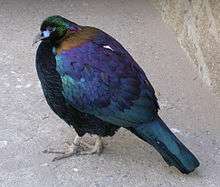Chinese monal
The Chinese monal (Lophophorus lhuysii) is a pheasant. This monal is restricted to mountains of central China. The plumage is highly iridescent. The male has a large drooping purple crest, a metallic green head, blue bare skin around the eyes, a reddish gold mantle, bluish green feathers and black underparts. The female is dark brown with white on its throat.
| Chinese monal | |
|---|---|
 | |
| Captive male L. lhuysii | |
| Scientific classification | |
| Kingdom: | Animalia |
| Phylum: | Chordata |
| Class: | Aves |
| Order: | Galliformes |
| Family: | Phasianidae |
| Genus: | Lophophorus |
| Species: | L. lhuysii |
| Binomial name | |
| Lophophorus lhuysii Geoffroy Saint-Hilaire & Verreaux, 1866 | |
This is the largest of the three monals and, by mass, is one of the largest pheasants (after the turkeys and the green and Indian peafowls). Males measure 76–80 cm (30–31 in) in length while females measure 72–75 cm (28–30 in). The mean weight is reportedly 3.18 kg (7.0 lb).[2]
The scientific name, lhuysii, commemorates the French statesman Édouard Drouyn de Lhuys.[3]
Due to ongoing habitat loss and degradation, limited range and illegal hunting, the Chinese monal is evaluated as vulnerable on IUCN Red List of Threatened Species. It is listed on Appendix I of CITES.
In captivity
London Zoo and Beijing Zoo have kept Chinese monal but all attempts to establish a captive breeding population failed.
References
- BirdLife International (2013). "Lophophorus lhuysii". IUCN Red List of Threatened Species. 2013. Retrieved 26 November 2013.CS1 maint: ref=harv (link)
- Biddle, Tami Davis, Pheasants, Partridges, and Grouse : A Guide to the Pheasants, Partridges, Quails, Grouse, Guineafowl, Buttonquails, and Sandgrouse of the World (Princeton Field Guides). Princeton University Press (2002), ISBN 978-0-691-08908-9
- Jobling, James A (1991). A Dictionary of Scientific Bird Names. OUP. ISBN 0 19 854634 3.
